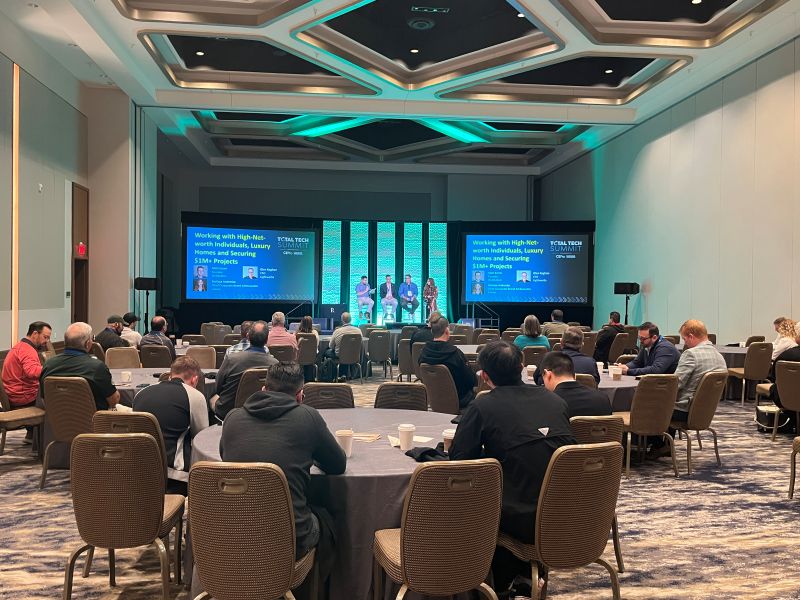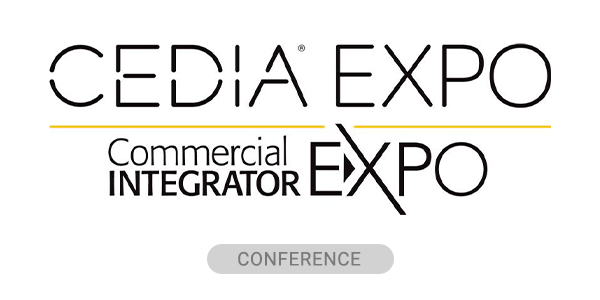At Total Tech Summit 2025, a panel of industry experts convened to dissect one of the custom integration channel’s most sought-after and challenging sectors: the world of ultra-high-net-worth luxury projects. Moderated by CE Pro‘s Executive Editor Zach Comeau, the discussion moved beyond simple smart home control, delving into the nuanced art of creating experiences where technology is felt but not seen. Panelists included: Matt Emmi, Founder, One Button; Glen Koghan, CFO, Lightworks; Melissa Andresko, chief corporate brand ambassador, Lutron. The experts panelist collectively painted a picture of a market driven by discretion, trust and flawless execution.
The conversation kicked off with a shared philosophy. “The goal is simplicity, discretion and seamless design,” Comeau stated, setting the stage for a deep dive into how top-tier integrators achieve this elusive trifecta.
One Button’s Emmi, emphasized this point. He described a business built on an engineering-first foundation, which evolved to serve a clientele that demands aesthetic perfection. Lightworks’ Koghan echoed this, noting his firm’s core mission is “making technology blend seamlessly with design.”
Lutron’s Andresko’s offered a manufacturer’s perspective, highlighting a crucial market shift. “We’ve moved from selling products to selling experiences,” she explained. “It’s about creating a special atmosphere in homes, leveraging our 60-year legacy of quality and innovation to do so.”
The Currency of Trust in High-Stakes Projects
In a world of discerning clients and multi-million dollar homes, how does an integrator establish the credibility needed to get a seat at the table? Trust, the panelists agreed, is the most valuable asset.
For Lightworks, credibility is rooted in a deep specialization. “Our background is in electrical and lighting design,” Koghan shared. “This expertise, combined with long-term collaborations with high-end residential builders, speaks for itself. Project case studies are essential to visually validate that trust.”
Lutron’s approach, according to Andresko, is built on a foundation of reliability. “Our legacy of quality and innovation is key, but it’s backed by a fanatical focus on customer service,” she said. “We make products that are not only beautiful and easy to use but are also built to last.”
Emmi recounted his firm’s breakthrough in the competitive New York market, crediting the endorsement of a respected industry figure for opening doors. This highlights the power of both personal and institutional legitimacy. Winning that initial trust is the first, and perhaps most critical, hurdle.
Navigating the Complexities of High-Value Projects
Once trust is established, the real work begins. High-value projects present unique challenges, from complex stakeholder webs to sky-high expectations for service. Emmi detailed the critical need to understand the chain of command. “You have to know if you’re working directly with the client or through project managers,” he stressed. “Understanding the decision-making process and maintaining meticulous documentation is non-negotiable to avoid chaos.”
Kgghan reinforced the importance of front-end clarity. “You must understand the full project scope, the decision criteria, and the homeowner’s true involvement from the outset.” This early discovery process prevents costly misalignments later.
Andresko pointed to early and frequent communication as the antidote to project pitfalls. “Getting in front of clients and their representatives early avoids misunderstandings and change orders down the line,” she advised. “It’s about managing expectations before they become problems.”
The Transformative Power of Light
A significant portion of the discussion centered on lighting and shading, which have evolved from functional necessities to central pillars of the luxury experience. Andresko spoke to the rising trend of wellness within the home. “Clients want to create a spa-like environment, and lighting and shading are central to that,” she explained. “The ability of wireless systems to scale allows us to bring dynamic, natural light control to any space, enhancing well-being.”
Emmi was emphatic: “Adaptive, tunable lighting is no longer a nice-to-have; it is essential for creating a true luxury environment.”
Koghan explained how this integration works in practice. “Lighting design doesn’t exist in a vacuum. It integrates with shading, architecture and interior design to enhance the entire experience. It’s a choreographed dance of elements.”
Designing for Disappearance: Service and Support
What happens after the installation? The panel was unanimous: the best service is the service a client never needs. “My approach is to design systems that are so reliable they require minimal service,” Emmi stated. He emphasized choosing products with a proven low mean time between failures, effectively engineering out the need for support calls.
Koghan agreed, adding a crucial technical layer. “We insist on owning the network. A robust, professionally managed network is the backbone of a reliable system and minimizes the need for our team to intervene.”
From the manufacturer’s side, Andresko highlighted the safety net that a global brand provides. “When issues do arise, remote service capabilities and 24/7 tech support are vital,” she said. “Our commitment to innovation is as much about ensuring product reliability as it is about creating new features.”
Marketing the Invisible
Selling a service that is, by design, invisible requires a sophisticated marketing strategy. Emmi championed the power of visual storytelling. “High-quality imagery, detailed case studies and industry awards are how we showcase our work and build credibility,” he noted. His firm’s own “one-button website” was held up by Andresko as a gold standard for presenting projects with elegance and impact.
For Koghan, the proof is in the experience. “Showrooms and design centers are critical,” he said. “They allow us to demonstrate our capabilities tangibly, letting clients and design partners see, touch and feel the quality of the experience we deliver.”
Lessons from the Field
Experience is a powerful teacher, and the panelists shared hard-won lessons. Koghan recounted a project where the client was absent until the final stages, leading to significant and costly changes. The takeaway? “Client involvement is not optional.”
Emmi reiterated the importance of understanding who holds the authority to make decisions, while Andresko drove home the theme of proactive engagement. “Early interaction prevents so many problems. It’s the most important lesson we can share.”
Finally, the panel addressed the art of building a powerful referral network. Emmi described a targeted approach. “We identify top architects and designers from trade magazines and awards, then offer them valuable content and experiences, like AIA-accredited courses.”
This high-level discussion at the Total Tech Summit provided a masterclass in the luxury integration market. Success is not about the latest gadget or the most complex system. It’s about a disciplined, design-focused approach built on a foundation of trust, reliability and an unwavering commitment to making technology disappear into the fabric of a beautifully designed home.




